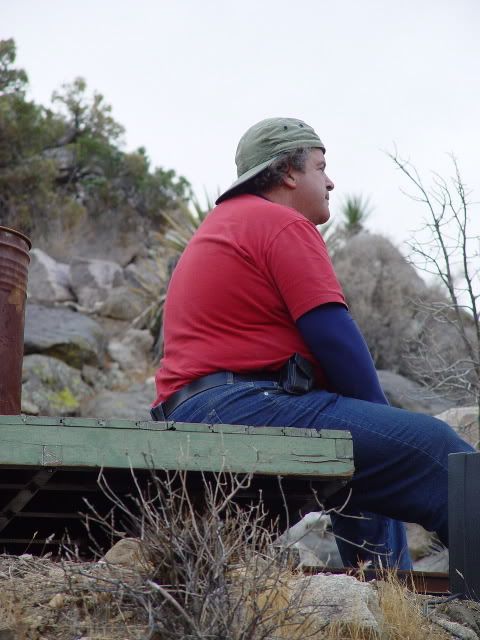Here are a couple of items sent in by guest blogger Ken Eells, our jovial roundhouse foreman. Enjoy! - Chris
Railroad Scenery of the Ages
What theme park magnates Walt Disney and Walter Knott had to go through to recreate naturalistic scenic settings for their park railroad attractions was nothing short of magnificent. However, for those of us constructing the JT&S Grand Scale Railway, we could never afford the astronomical costs associated with that level of scenic theming for the railroad. Instead, we have relied on Mother Nature to provide for our Grand Scale Railway: Her very “Grand Scale” scenery.
Born 100 million years ago as a molten liquid that made its way up to the earth’s surface and cooled into massive blocks of a granitic rock called Mozogranite, reshaped and reconstituted many times over with heat, pressure, wind and water has yielded a most amazing desert landscape with which to develop our rail line through.
While some may curse the extreme terrain that we must tackle, we both celebrate and relish the challenges that this unique desert landscape will impart. Once the first leg is graded and rail is laid up to the waterfall in the dry wash, then the dramatic Mojave Desert vistas and unique geology as experienced from the trains will be nothing short of Grand Scale.
-Ken Eells
The Grand Scale Turntable
Exciting news: those visiting our museum have turned the 15” gauge Grand Scale turntable into a real conversation piece. All sorts of questions are being asked regarding its design, construction and ultimate operation. So let’s take a brief look and answer some of those questions.
Our turntable is a very closely scaled representation of the one that was used in Ridgway Colorado on the Rio Grande Southern’s three foot gauge railroad. The original was built about 1900 and operated well into the 1950’s. The prototype 50 foot long bridge was constructed of riveted iron girders set in a stone pit. It serviced the seven stall brick roundhouse and operated with one inbound and one outbound track.
In 5” scale, our welded steel bridge is 20’-10” long which is very sizable in its own right. Just like its big brother, the bridge floats on a center thrust bearing. On either end are two iron caster wheel assemblies that engage the top of the ring rail only when a piece of railroad equipment is rolled onto or off of the turntable. When a locomotive is perfectly balanced on the bridge, the center thrust bearing takes the complete load, leaving the wheels to ride about ¼” above the top of the ring rail.
In this configuration the locomotive can be easily turned by one person. This is exactly how the prototype operated, though you could expect to see as many as four men turning the heaviest locomotives. That is how these Victorian era pieces of railroad equipment earned the endearing term of “Armstrong” turntables.
-Ken Eells
Railroad Scenery of the Ages
What theme park magnates Walt Disney and Walter Knott had to go through to recreate naturalistic scenic settings for their park railroad attractions was nothing short of magnificent. However, for those of us constructing the JT&S Grand Scale Railway, we could never afford the astronomical costs associated with that level of scenic theming for the railroad. Instead, we have relied on Mother Nature to provide for our Grand Scale Railway: Her very “Grand Scale” scenery.
Born 100 million years ago as a molten liquid that made its way up to the earth’s surface and cooled into massive blocks of a granitic rock called Mozogranite, reshaped and reconstituted many times over with heat, pressure, wind and water has yielded a most amazing desert landscape with which to develop our rail line through.
While some may curse the extreme terrain that we must tackle, we both celebrate and relish the challenges that this unique desert landscape will impart. Once the first leg is graded and rail is laid up to the waterfall in the dry wash, then the dramatic Mojave Desert vistas and unique geology as experienced from the trains will be nothing short of Grand Scale.
-Ken Eells
The Grand Scale Turntable
Exciting news: those visiting our museum have turned the 15” gauge Grand Scale turntable into a real conversation piece. All sorts of questions are being asked regarding its design, construction and ultimate operation. So let’s take a brief look and answer some of those questions.
Our turntable is a very closely scaled representation of the one that was used in Ridgway Colorado on the Rio Grande Southern’s three foot gauge railroad. The original was built about 1900 and operated well into the 1950’s. The prototype 50 foot long bridge was constructed of riveted iron girders set in a stone pit. It serviced the seven stall brick roundhouse and operated with one inbound and one outbound track.
In 5” scale, our welded steel bridge is 20’-10” long which is very sizable in its own right. Just like its big brother, the bridge floats on a center thrust bearing. On either end are two iron caster wheel assemblies that engage the top of the ring rail only when a piece of railroad equipment is rolled onto or off of the turntable. When a locomotive is perfectly balanced on the bridge, the center thrust bearing takes the complete load, leaving the wheels to ride about ¼” above the top of the ring rail.
In this configuration the locomotive can be easily turned by one person. This is exactly how the prototype operated, though you could expect to see as many as four men turning the heaviest locomotives. That is how these Victorian era pieces of railroad equipment earned the endearing term of “Armstrong” turntables.
-Ken Eells






